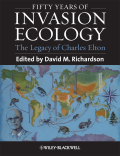
Fifty years of invasion ecology: the legacy of Charles Elton
Richardson, David M.
INDICE: Contributors. Foreword. Introduction. PART 1 HISTORICAL PERSPECTIVES. 1 A world of thought: 'The Ecology of Invasions by Animals and Plants' and Charles Elton's life's work (ROGER L. KITCHING). 2 Charles Elton: neither founder nor siren, but prophet (DANIEL SIMBERLOFF). 3 The inviolate sea? Charles Elton and biological invasions in the world's oceans (JAMES T. CARLTON). 4 The rise and fall of biotic nativeness: a historical perspective (MATTHEW K. CHEW AND ANDREW L. HAMILTON). PART 2 EVOLUTION AND CURRENT DIMENSIONS OF INVASION ECOLOGY. 5 Patterns and rate of growth of studies in invasion ecology (HUGH J. MACISAAC, RAHEL A. TEDLA AND ANTHONY RICCIARDI). 6 Invasion ecology and restoration ecology: parallel evolution in two fi elds of endeavour (RICHARD J. HOBBS AND DAVID M. RICHARDSON). PART 3 NEW TAKES ON INVASION PATTERNS. 7 Biological invasions in Europe 50 years after Elton: time to sound the ALARM (PETR PY'EK AND PHILIP E. HULME). 8 Fifty years of tree pest and pathogen invasions, increasingly threatening world forests (MICHAEL J. WINGFIELD, BERNARD SLIPPERS, JOLANDA ROUX AND BRENDA D. WINGFIELD). PART 4 THE NUTS AND BOLTS OF INVASION ECOLOGY. 9 A movement ecology approach to study seed dispersal and plant invasion: an overview and application of seed dispersal by fruit bats (ASAF TSOAR, DAVID SHOHAMI AND RAN NATHAN). 10 Biodiversity as a bulwark against invasion: conceptual threads since Elton (JASON D. FRIDLEY). 11 Soil biota and plant invasions: biogeographical effects on plantmicrobe interactions (RAGAN M. CALLAWAY AND MARNIE E. ROUT). 12 Mutualisms: key drivers of invasions.. key casualties of invasions (ANNA TRAVESET AND DAVID M. RICHARDSON). 13 Fifty years on: confronting Elton's hypotheses about invasion success with data from exotic birds (TIM M. BLACKBURN, JULIE L. LOCKWOOD AND PHILLIP CASSEY). 14 Is rapid adaptive evolution important in successful invasions? (ELEANOR E. DORMONTT, ANDREW J. LOWE AND PETER J. PRENTIS). 15 Why reproductive systems matter for the invasionbiology of plants (SPENCER C.H. BARRETT). 16 Impacts of biological invasions on freshwater ecosystems (ANTHONY RICCIARDI AND HUGH J. MACISAAC). 17 Expanding the propagule pressure concept to understand the impact of biological invasions (ANTHONY RICCIARDI, LISA A. JONES, ÅSA M. KESTRUP AND JESSICA M. WARD). PART 5 POSTER-CHILD INVADERS, THEN AND NOW. 18 Elton's insights into the ecologyof ant invasions: lessons learned and lessons still to be learned (NATHAN J. SANDERS AND ANDREW V. SUAREZ). 19 Fifty years of 'Waging war on cheatgrass': research advances, while meaningful control languishes (RICHARD N. MACK). PART 6 NEW DIRECTIONS AND TECHNOLOGIES, NEW CHALLENGES. 20 Researching invasive species 50 years after Elton: a cautionary tale (MARK A. DAVIS). 21 Invasions andecosystems: vulnerabilities and the contribution of new technologies (PETER M. VITOUSEK, CARLA M. DANTONIO AND GREGORY P. ASNER). 22 DNA barc
- ISBN: 978-1-4443-3585-9
- Editorial: Wiley-Blackwell
- Encuadernacion: Cartoné
- Páginas: 456
- Fecha Publicación: 31/12/2010
- Nº Volúmenes: 1
- Idioma: Inglés
